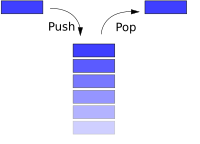Queue-A queue (pronounced /kjuː/) is a particular kind of collection in which the entities in the collection are kept in order and the principal (or only) operations on the collection are the addition of entities to the rear terminal position and removal of entities from the front terminal position. This makes the queue a First-In-First-Out (FIFO) data structure. In a FIFO data structure, the first element added to the queue will be the first one to be removed. This is equivalent to the requirement that whenever an element is added, all elements that were added before have to be removed before the new element can be invoked. A queue is an example of a linear data structure.
Queues provide services in computer science, transport and operations research where various entities such as data, objects, persons, or events are stored and held to be processed later. In these contexts, the queue performs the function of a buffer.
Queues are common in computer programs, where they are implemented as data structures coupled with access routines, as an abstract data structure or in object-oriented languages as classes. Common implementations are circular buffers and linked lists.
Illustration:



Reference:http://en.wikipedia.org/wiki/Queue_(data_structure)
http://images.google.com.ph/images?um=1&hl=en&q=Queue+in+Data+Structure&btnG=Search+Images








